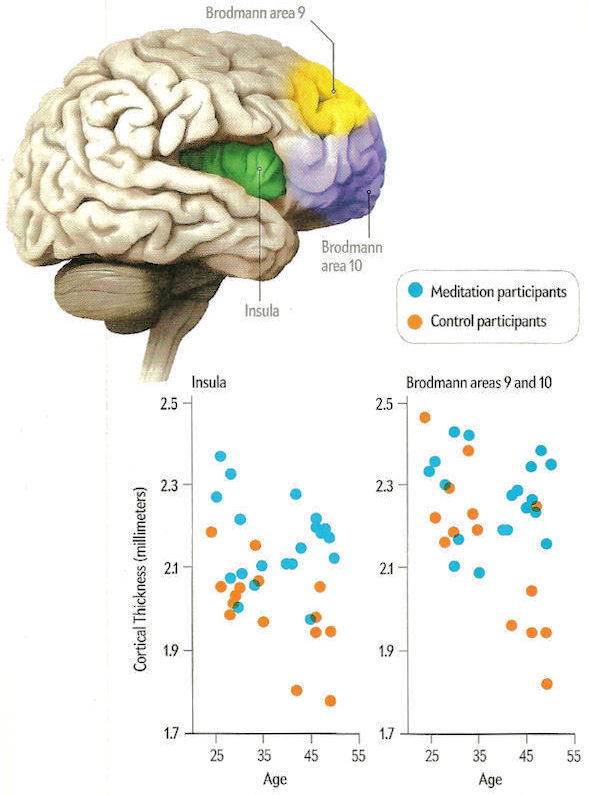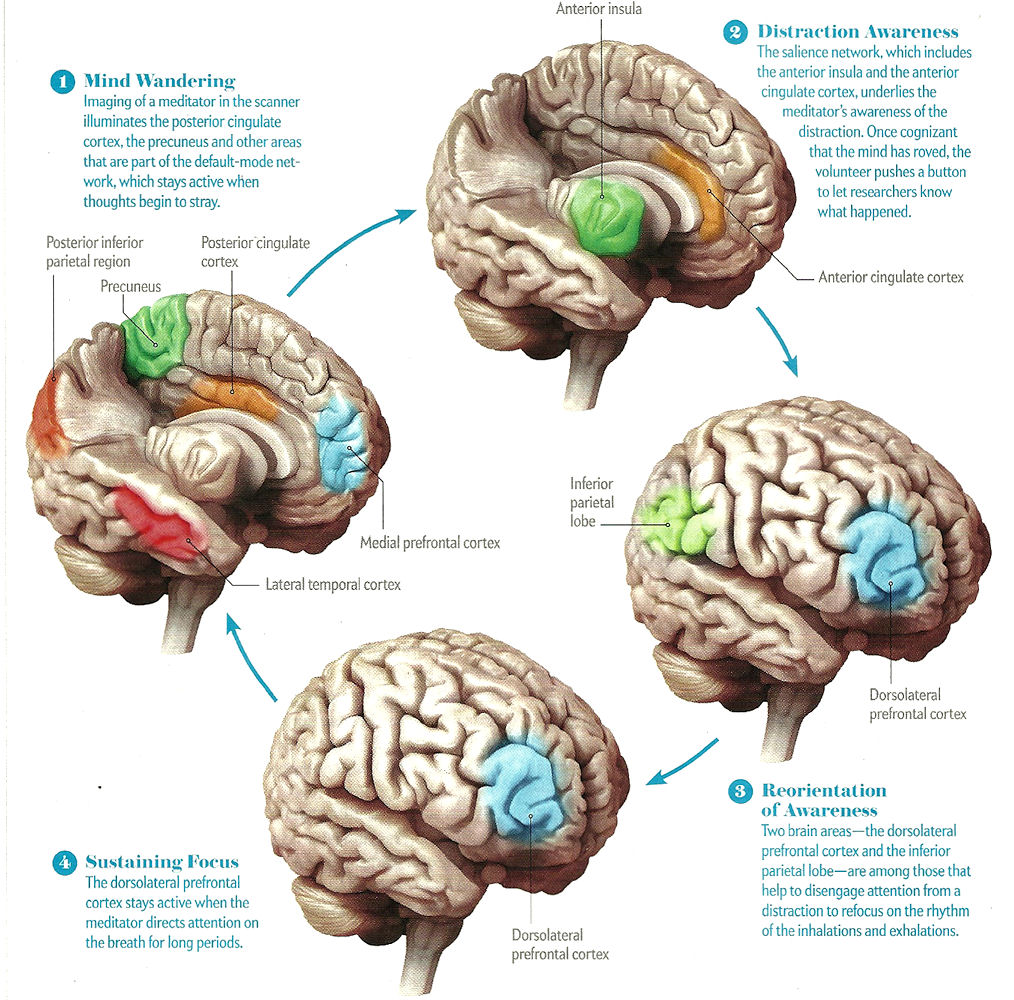

| Home Page | Overview | Site Map | Index | Appendix | Illustration | Preface | Contact | Update | FAQ |
 |
 |
meditation is different from sleeping or dreaming. It generates brainwaves in the Theta state, which is in a slightly higher frequency range than the Delta (sleeping) state (see Figure 10-21). The state is on the border line between consciousness and sleeping. The anterior cingulate gyrus becomes underactive in meditation (see Figure 10-24b). It is known that the cingulate gyrus concentrates on internal stimuli, and contains the feeling of self. Curiously, this is the same area that becomes underactive in hypnosis (when the identity of self dissolved) and Schizophrenia (when own thoughts are confused with outside voices). Thus it doesn't seem to be accidental that in meditation, the sense of boundaries is lost and it induces a feeling of "at one" (union) with the universe. |
Figure 10-24a Meditation [view large image] |
Figure 10-24b Meditating Brain |
 |
Meditation, nearly as old as humanity, has always been part of Eastern religions. Starting from 2nd century A.D. meditation became important part of Christian practice until early 1500s when Martin Luther disapproved mysticism. Jewish and Muslim meditations have established around 1000 A.D. Meditation was used as a medium to communicate with the higher being(s). Actually, the brain is playing trick on the practitioners by producing various illusions. Now the West is rediscovering the benefits of meditation. In its most modern forms, it has dropped the mantra bit that has the subject memorize a secret phrase or syllable; instead it only requires focusing on a sound or breathing. In fact, just closing the eyes in a quiet place (to block sensory inputs) and relaxing the mind (to minimize internal processing) would attain the same result without much ado. Figure 10-25a displays a 2011 update on the many measurable benefits by scientific studies. |
Figure 10-25a Meditation, 2011 [view large image] |
 |
 |
While many benefits of meditation have been unveiled gradually in the last 15 years, recent (~2014) neuro-scientific findings have shown that the adult brain can still be transformed through experiences including meditation. Figure 10-25b shows the growth of cortical material by experiments with 20 meditation and control participants respectively. A 2014 article defines meditation as the cultivation of basic human qualities, such as a more stable and clear mind, emotional balance, a sense of caring mindfulness, even love and compassion - qualities that remain latent as long as one does not make an effort to develop them. It is also a process of familiarization with a more serene and flexible way of being. Meditation is categorized into three major types as shown in Table 10-02a. |
Figure 10-25b Brain Growth |
Figure 10-25c Focused Meditation |
| Type | Method | Benefits | Brain Area(s) |
|---|---|---|---|
| Focused Attention | Concentrate attention on something with corrective steps to bring back wandering thought (see Figure 10-25c) | Better focus, less anxiety, more creativity | Sustaining foeus occurs at the dorsolateral prefrontal cortex (see Figure 10-25c) |
| Mindfulness | Let strayed thought to float by without reacting | Less stress, improved sleep patterns, lower the risk of infection and depression | Activity decreases in insular§ cortex and amygdala; increases in dorsolateral prefrontal cortex (see Figure 10-25c) |
| Compassion | Practice generosity and visualize suffering of others | Reinforcement of inner balance, strength of mind, and a courageous determination to help those who suffer | Actitity increases in insula cortex, temporal parietal junction, medial prefrontal cortex |
 |
 |
A mis-conception about meditation is to associate "silence of the brain" with successful session. This seems to stem from the mis-interpretation of the term "Silent Sitting" (ÀR§¤) in Chinese. Actually, the brain never sits still. It would turn into the default mode during the inactive state. It becomes "silence" only in brain death (see definitions in Figure 10-25d). Thus, only a relaxed state can be achieved by minimizing external and internal stimulations. |
Figure 10-25d Brain Death Definition [view large image] |
Figure 10-25e Internal Vision [view large image] |
Internal stimulations mostly involve thinking about the past, planning on the future, and monitoring the present condition. |
 |
|
Idea Powered by Energy |
See "Default State" for restless brain, the 2024 article about "Brain burns through the same amount of energy whether you’re daydreaming or taking an exam", and Tao (¹D). |




 Inner Silence
Inner Silence











